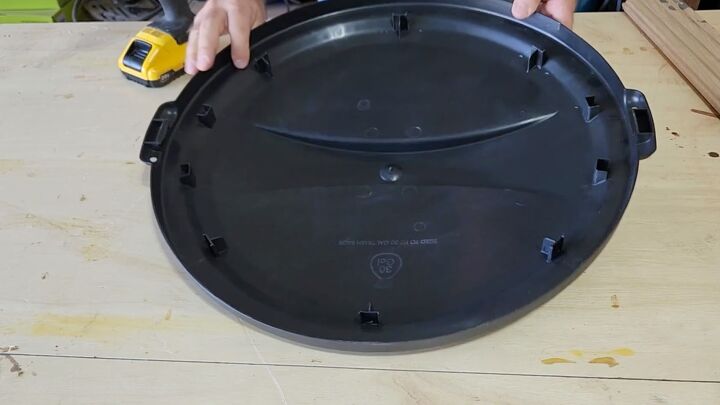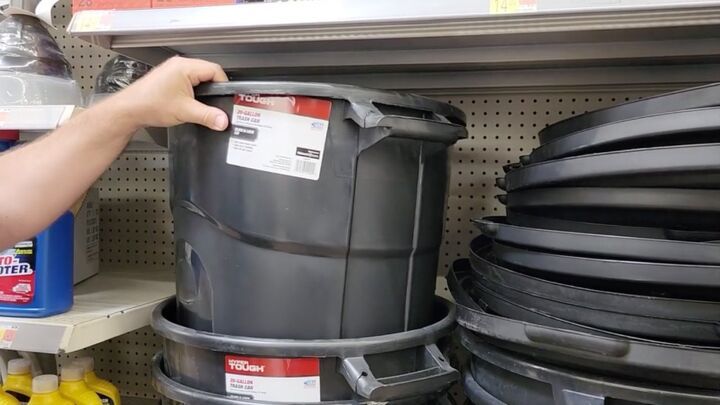Conserving water has never been so important and today I want to show you how to make your own rain barrel with a few things you can pick up at Walmart.

To start this project, I headed to my local Walmart to grab a small waste container that came with a lid.

You will want a lid with a nice concave curve which will be best for collecting the rainwater.

Turn the lid upside down and place a piece of scrap wood under the middle area.

Drill two holes into the lid. You will want to use a minimum size of one inch for the drill bit so that the water will quickly enter the can. Drill at least two spots as closeto the lowest part so there will not be any standing water.

Once you have drilled through the lid, turn the lid over and use a small knife to cut away any burrs or plastic. This will keep any debris from getting caught to clog up the holes.

Next, use a small piece of mesh as a filter to keep any leaves from getting into the lid. I used a four-inch piece of metal mesh that I glued down to the lid.

Lay a bead of hot glue across one side of the area where you drilled the holes.

Use a disposable paint stick to help lay out the screen so you don’t get burned by the hot glue before it cools. Using the stick, I press the mesh all across the lid to get good adhesion.

Next, add some zigzags of hot glue along the sides and the back and press the mesh down. This will give it a nice adhesion to the lid. Don’t worry too much about how it looks since this will be on the bottom of the lid once it is placed on the can.

Once it is flipped back over, you can see the nice clean look of the lid and how the mesh will make an excellent filter.

Now it is time to pick out a faucet so you can retrieve the water. Look for a spigot that allows the water to flow out with ease.

Choose a drill bit that is just about the same size as a threaded connection on the back to drill a hole for the faucet.

When selecting the area on the bucket to drill, never drill right at the bottom but mark a spot just an inch or two higher. This allows any small dirt or debris to rest on the bottom so that it won’t clog up the spigot when using it for the water.

Drill into the marked area on your bucket. Be careful not to press too hard, the drill bit will eventually pop through the plastic.

Next, use some plumbers tape to wrap the threads of the spigot. Typically you wouldn’t wrap as much as this on a normal plumbing job, but you will want to give it a good six to eight wraps for this project.

Once the tape is on the threads, place it on the hole of the bucket, and with a gentle push, start turning it clockwise. Eventually, the threads will grip the sides of the bucket and start to get tight.

Keep twisting until the spigot is tight against the walls of the bucket. Do not over-tighten. Make sure you stop as soon as it is snug. You can apply some clear silicone on the inside of the bucket to aid in the waterproofing if you desire.

The next step was to place the bucket and the lid on a stand that I put outside next to a downspout on my house. I cut the downspout so that any rain that falls on my roof will gather in the gutters and flow into the rain barrel.

I zip-tied the lid down so that it doesn’t blow off with the wind.

I finished just in time for a rare spring storm that moved into the area that afternoon. As the rain started to fall, the lid gathered the rain that fell. The gutters did their job and the water started to flow nicely. With even a 10th of an inch of rain in 800 square foot rough section will gather enough rain to fill a 50-gallon bucket. This small passing storm gave me at least 40 gallons of fresh rainwater.

Once I had water in my barrel, I was able to fill my watering can and use it to water the plants around the exterior of the house. It might not seem like a lot, but it is a great way to practice water conservation in many parts of the world. I really hope you enjoyed this project as much as I did.
